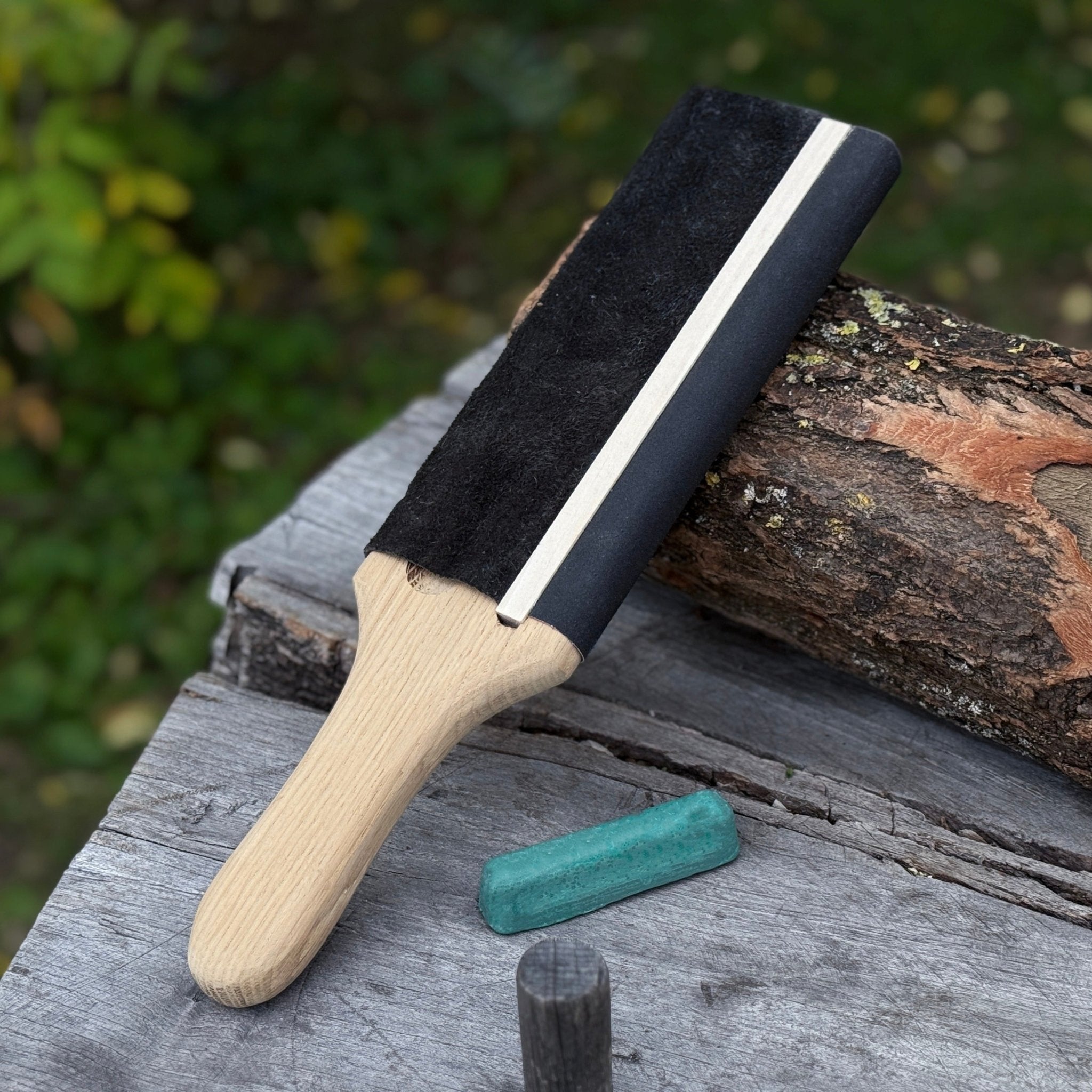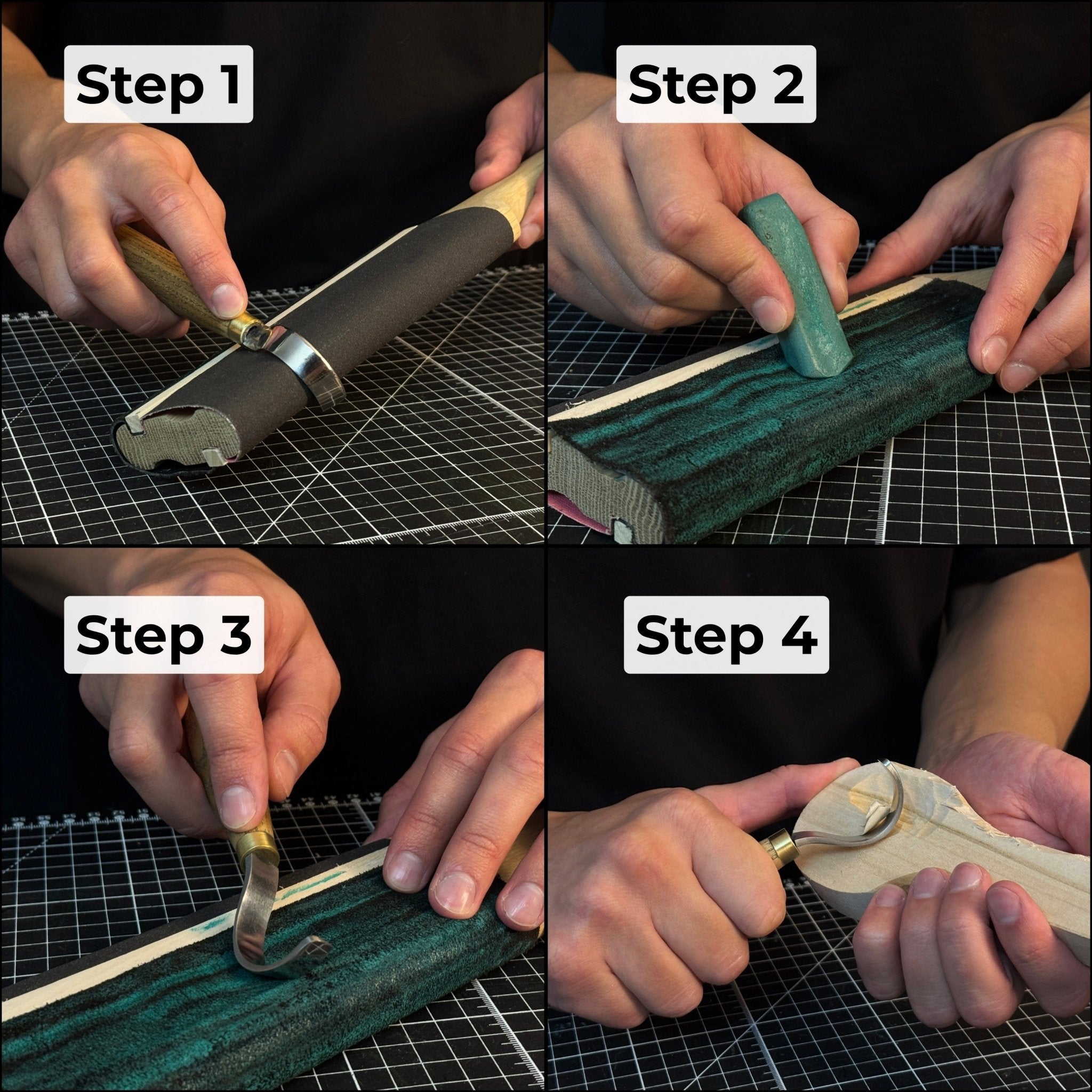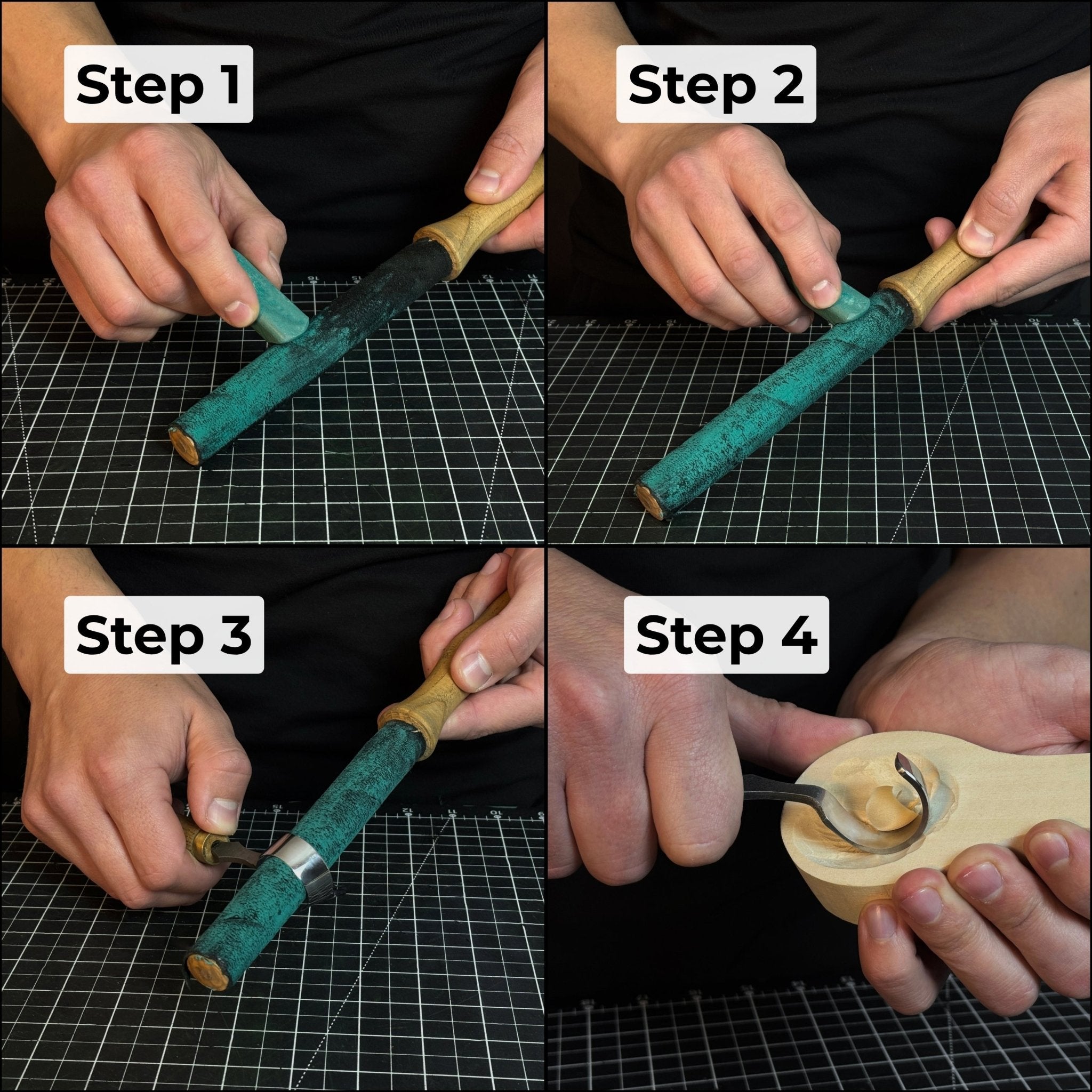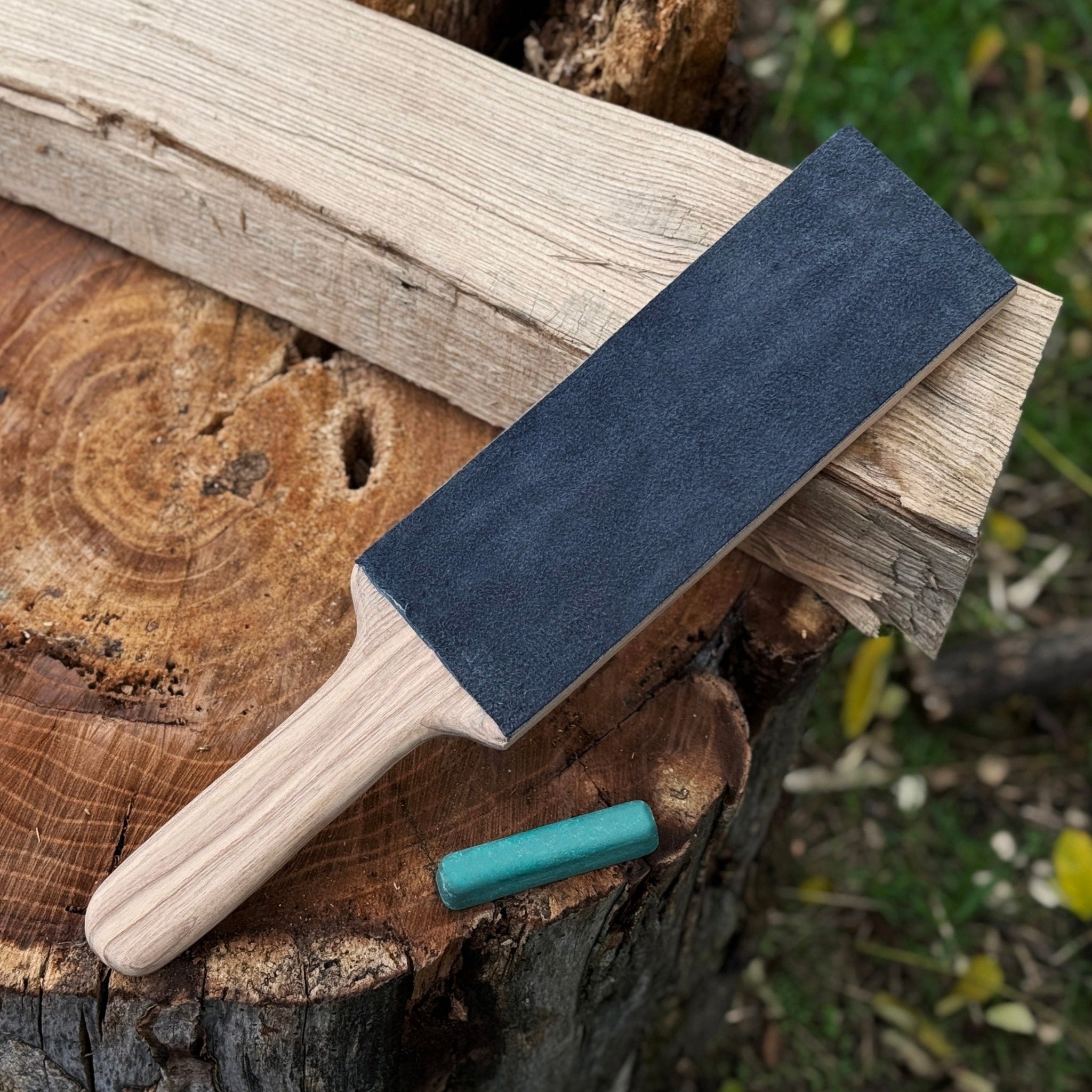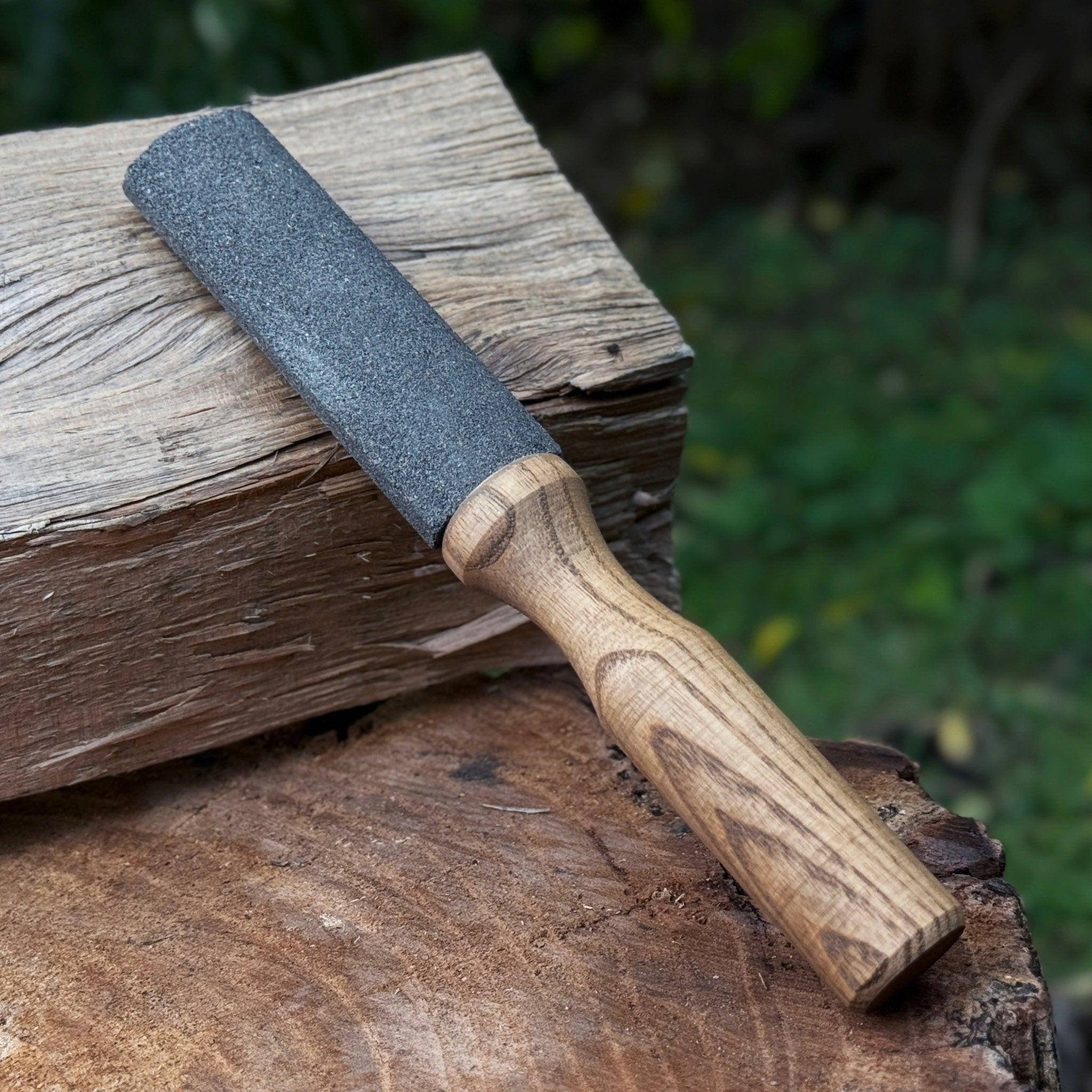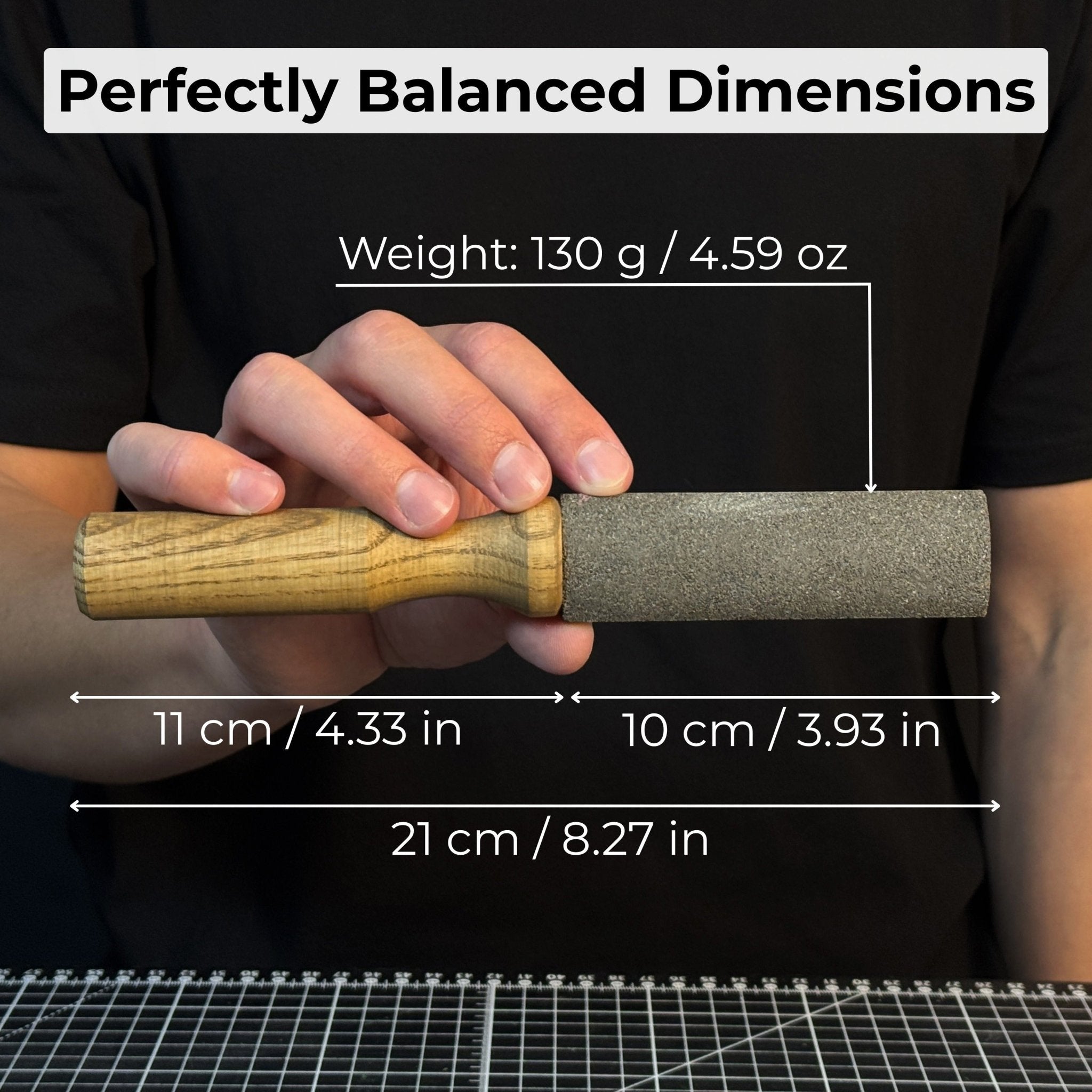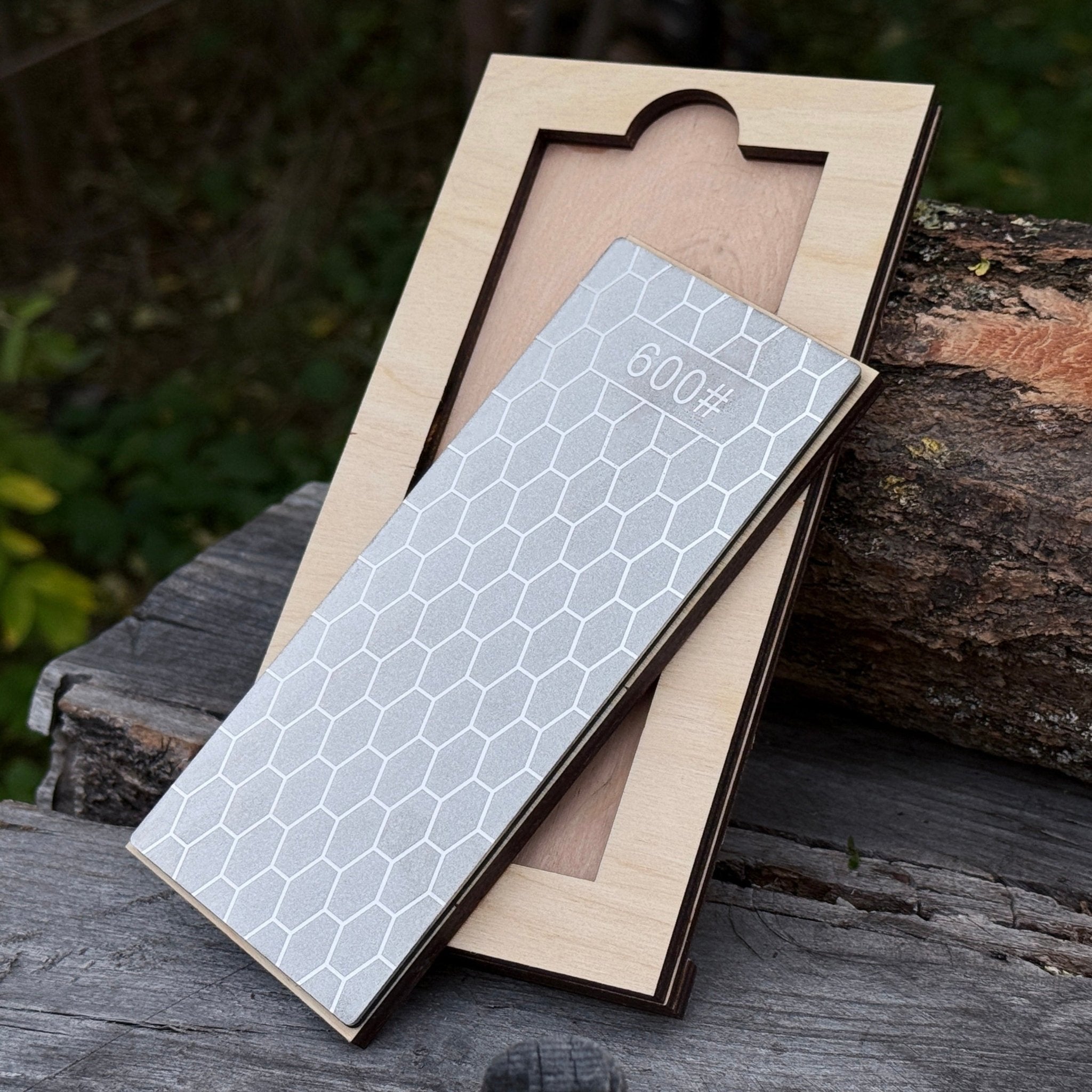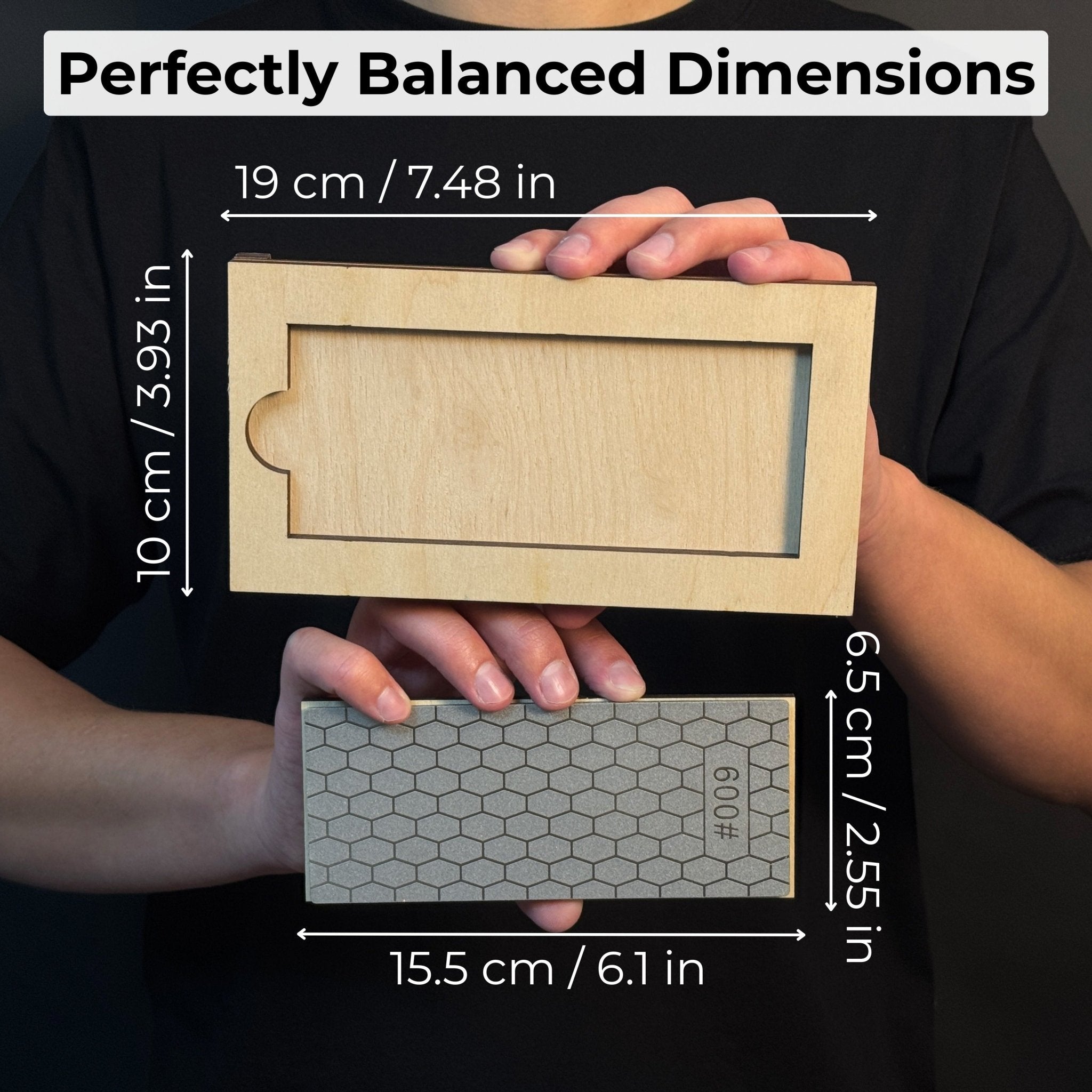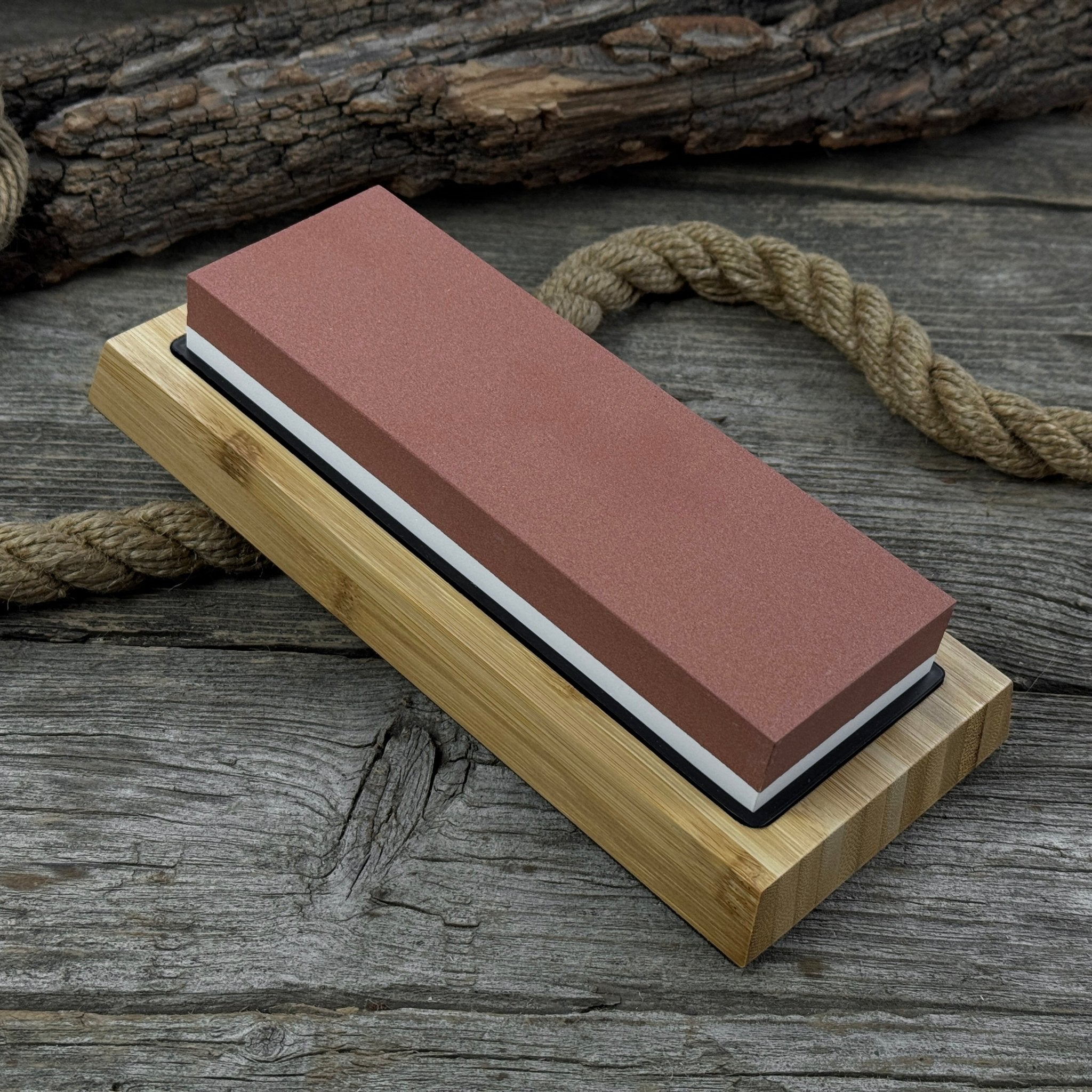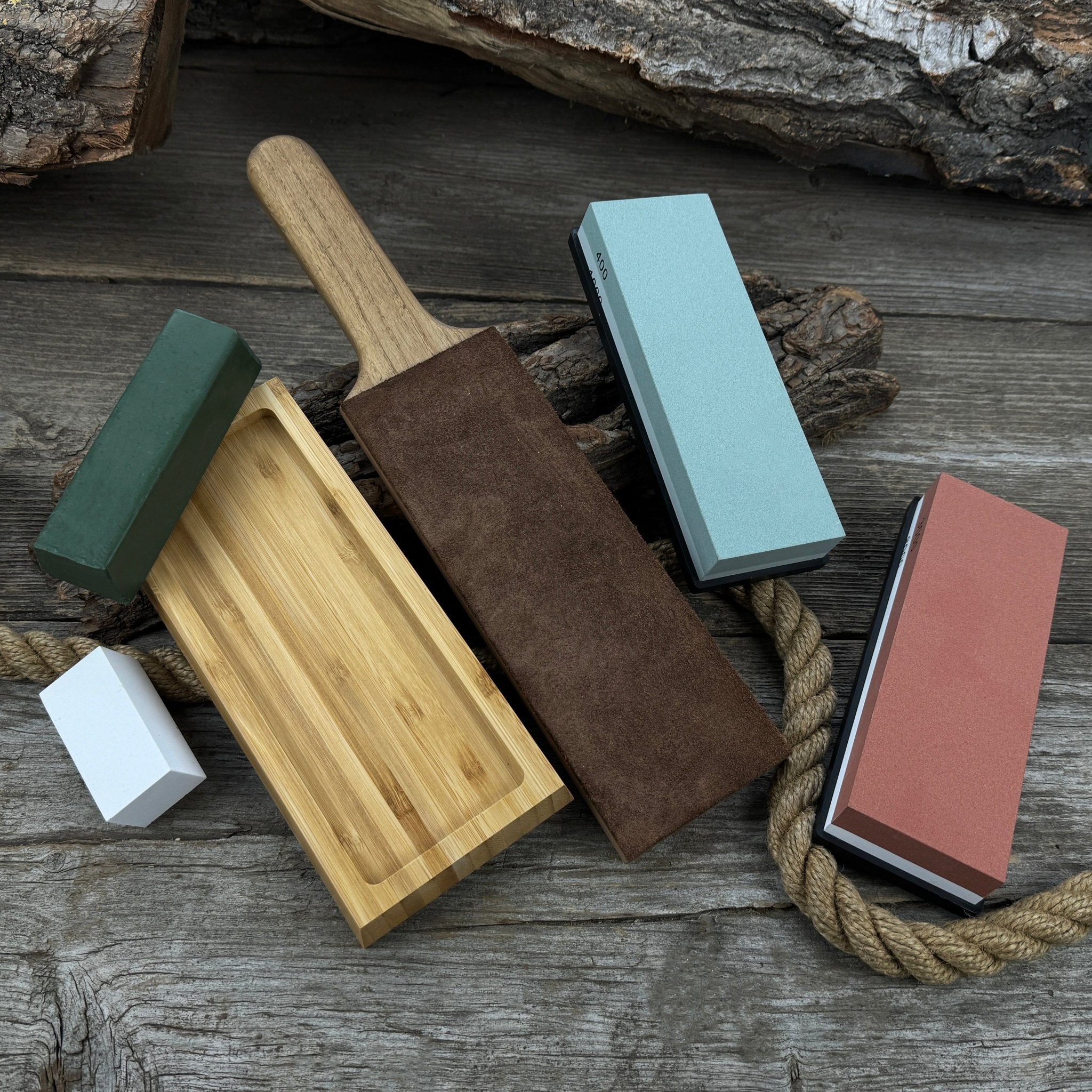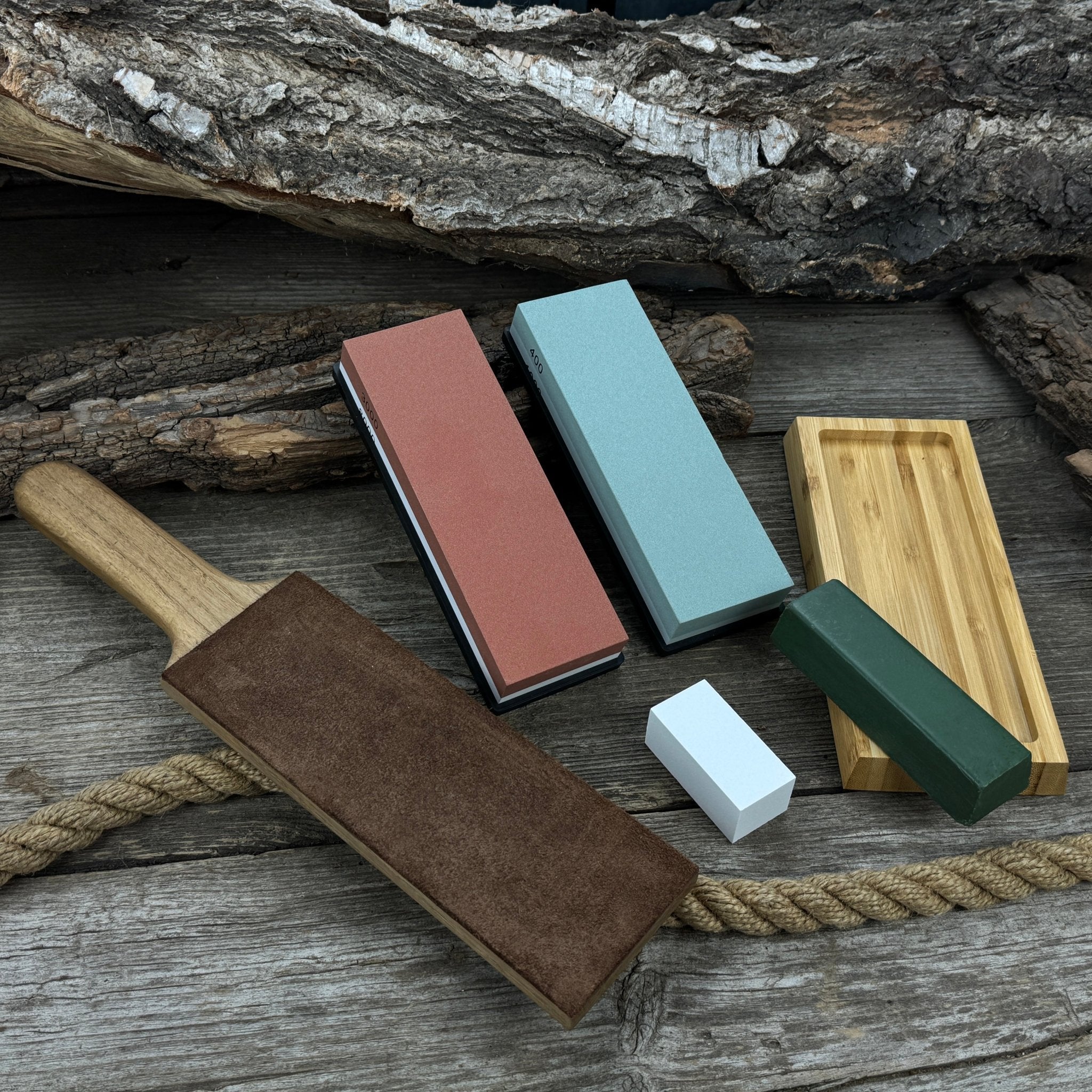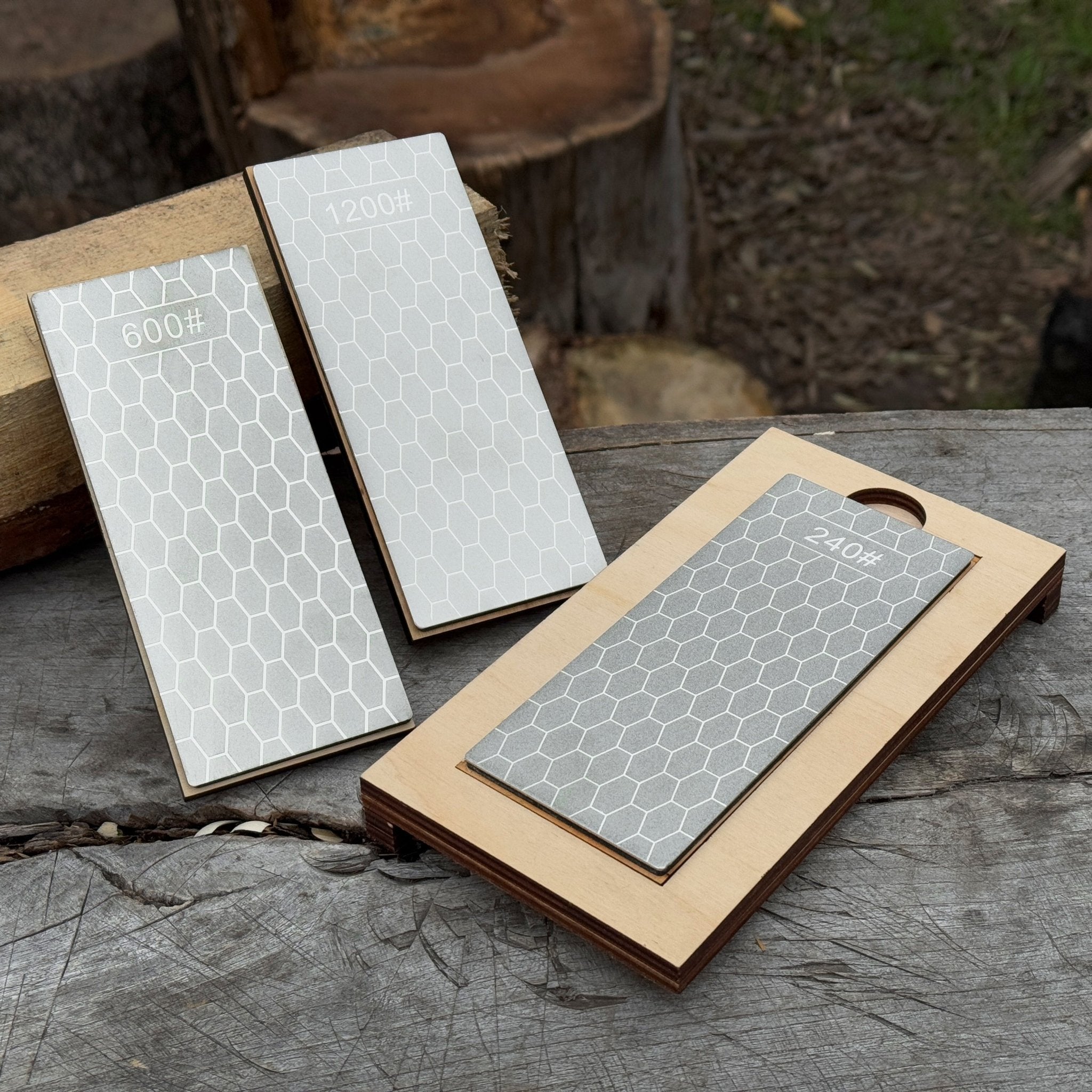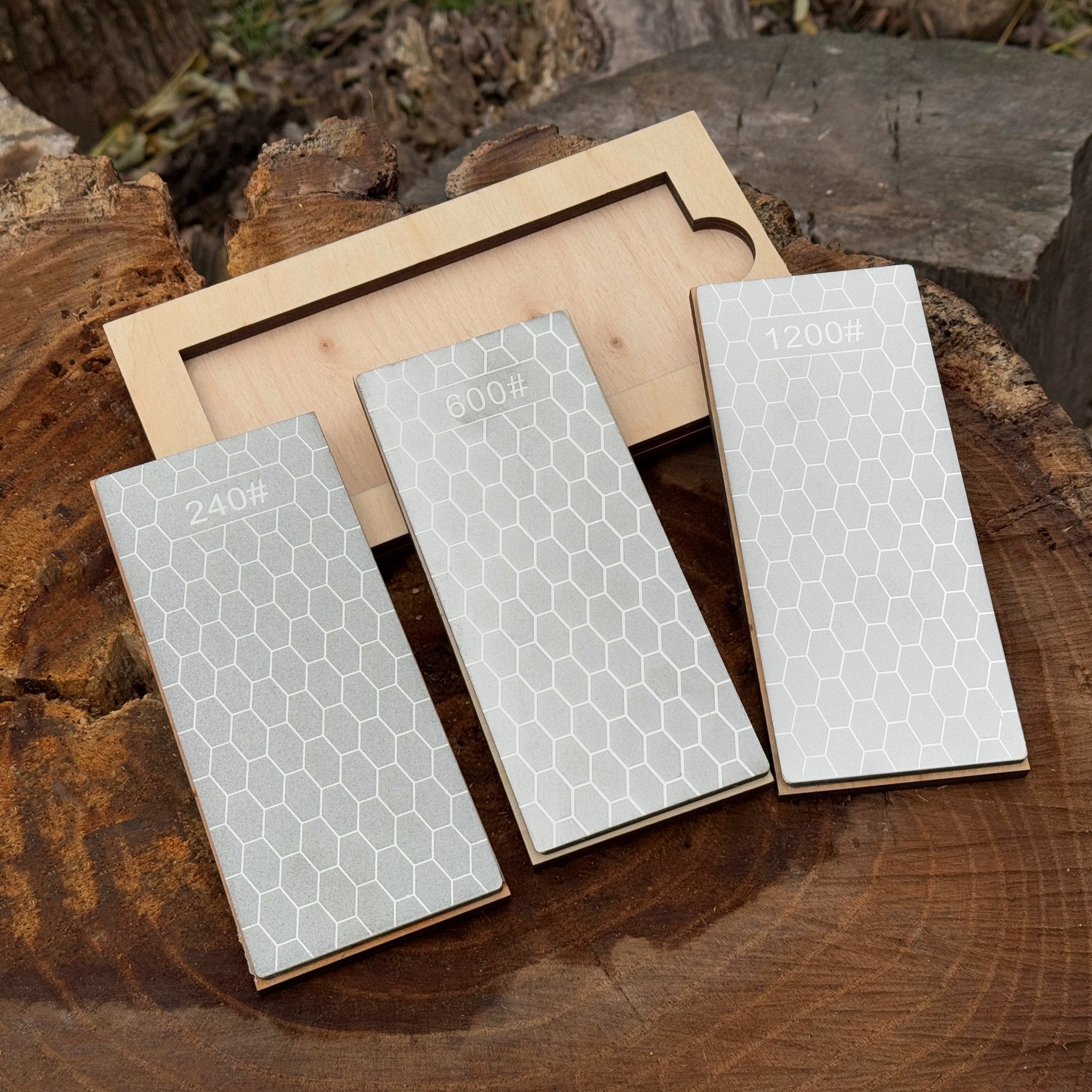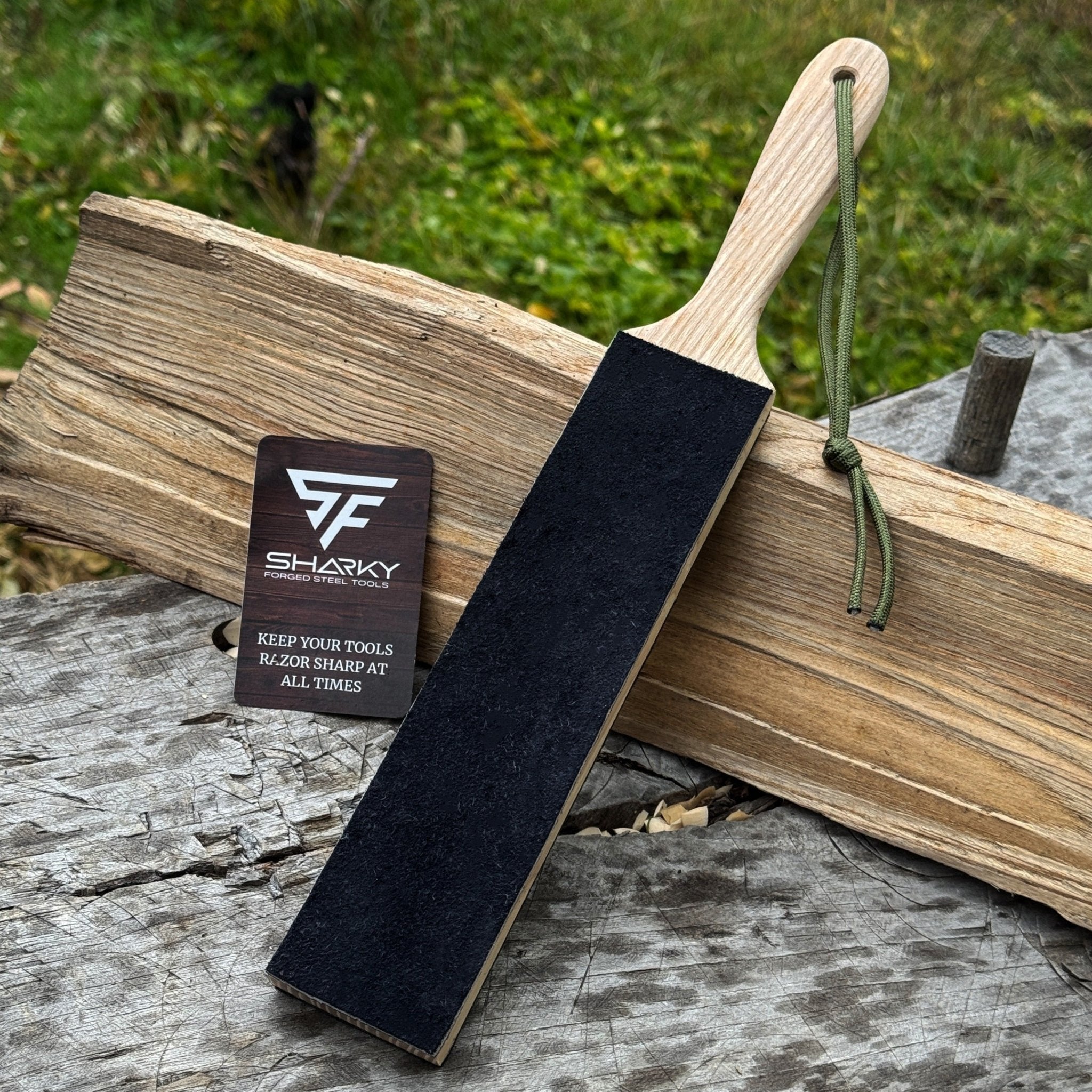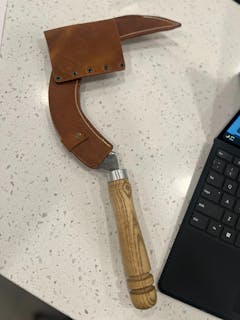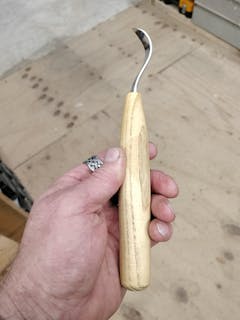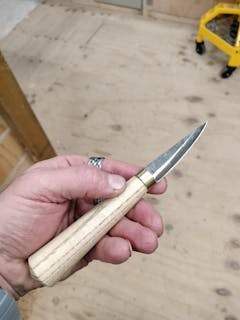Dual-Sided Leather Paddle Strop For Hook Knives & Gouges
Round Leather Strop For Knife Sharpening
One-Sided Leather Strop For Knife Sharpening & Polishing Compound
Diamond Grit Sharpening Stone for Scythes & Sickles

The Importance of Proper Knife Sharpening
Why Regular Knife Sharpening is Essential
Taking good care of knives is crucial, as it affects the overall work process, final output, and, most importantly, safety. A sharp knife cuts through materials more effortlessly and efficiently, which is why choosing the right sharpening supplies and accessories is as important as selecting the right knives for your project.
Proper knife sharpeners or sharpening systems ensure that knives maintain a razor-sharp edge, allowing for cleaner cuts.
Regular tool sharpening also minimizes the risk of slipping and injury by making the blade more predictable and controllable. Incorporating angle guides and strops helps maintain the correct sharpening angle and polish the edge to perfection. This also extends the life of the knives and prevents the blade from becoming too dull, which can lead to more aggressive sharpening sessions.
Well-maintained knives do not need to be replaced as often, and the cost of sharpening them is generally lower than the cost of new knives.
Among the most widely used sharpen tools, you will find:
- Knife Sharpeners and Whetstones: Japanese whetstones are a popular choice among knife enthusiasts. They come in various grits, each serving a specific purpose. Lower-grit stones are used to shape the blade's edge, while finer-grit stones polish blades.
- Sharpening Systems: These tend to be more expensive than knife sharpeners but are excellent for maintaining a consistent bevel angle.
- Strops: A leather strop paired with a polishing compound is the final step in the sharpening process. It polishes the blade edge and removes microscopic burrs, resulting in an exceptionally sharp cutting edge.
- Sandpaper and Files: For minor damage, such as nicks or a broken tip, sandpaper and small files can be used as temporary solutions. However, for optimal results, it is recommended to use more specialized sharpening tools.
Common Signs Your Knife Needs Sharpening
Even the best knives eventually dull. Here are a few signs that your knife might need attention:
- Difficulty Cutting: If you are struggling to cut through food, it is likely your knife has lost its edge.
- Visible Damage: Look for nicks, chips, or a rounded tip on the blade.
- Inconsistent Cuts: A dull knife can produce uneven cuts, making it harder to achieve precise results.
Here are some of the practical sharpening techniques that can be used to keep knives in good shape:
- Identify Knife Issues: To repair a broken tip, gently grind the back edge using sharpening tools like a sanding station, sandpaper, or files. Use safety precautions such as wearing goggles. For a small nick, general sharpening with appropriate knife sharpening supplies can remove it, but larger nicks may require grinding down the front edge.
- Sharpening Technique: Begin by locating the bevel (blade angle) and maintain it while applying controlled pressure. Alternate pressure on the push and pull strokes to maintain consistency.
- Stropping for Polish: After sharpening, polish the blade by stropping, which removes minor scratches and jagged edges, resulting in a sharp finish. Regular stropping during carving helps keep the edge sharper.
- Practice and Perseverance: If you are new to carving or leatherworking, practice on a cheap knife to get comfortable with the sharpening process. Mastering the technique with sharpening accessories requires lots of patience.
Understanding Different Knife Sharpening Tools
Initial sharpening and edge repair are done with sharpening supplies like sharpening stones and diamond plates. This sharpening knife equipment helps reshape dull or damaged blades. It is typically used for heavy-duty tasks to ensure the knife’s bevel angle is correctly set and formed.
The next step is to smooth out the blade with fine-grit stones or high-grit sandpaper. Ergonomic sandpaper strops offer a convenient and effective way to refine the edge, especially for intricate or curved blades.
The final stage is honing and polishing, best achieved with leather honing strops. Strops maintain an already sharp, apexed edge but do not reshape or form an edge. They can be used with various polishing compounds to maintain the edge's sharpness and refine the blade's surface. Each is designed for specific sharpening needs, e.g., single-sided strops refine the knife edge, dual-sided strops are used for multi-stage honing, while ergonomic sandpaper strops are ideal for sharpening curved blades.
Here’s a breakdown of how each of these sharpening tools can be used effectively:
- Dual-Sided Leather Paddle Strops
These versatile sharpening tools feature a coarse side that removes burrs after sharpening, while the fine side polishes the blade to a mirror finish. This tool saves time and space, ideal for maintaining edge sharpness between full sharpening sessions.
- Single-Sided Leather Strops
Perfect for daily blade maintenance. Loaded with a fine compound, these environmentally friendly tools quickly refresh the edge after minor use. This simple tool ensures a razor-sharp edge without significant material removal, preserving the blade's lifespan.
- Ergonomic Sandpaper Strops for Curved Blades
Ideal for sharpening curved or specialty blades. The flexible design and customizable grits allow for precise control and even sharpening across complex blade profiles.
Choosing the Right Knife Sharpening Supplies for Your Needs
Factors to Consider When Selecting a Strop
When selecting a strop, several key factors come into play:
- Leather Type: For the best sharpening results, choose high-quality vegetable-tanned leather, ideally 8–9 oz. This leather is smooth and holds compound well, reducing unnecessary abrasiveness that lower-quality leather may cause. High-quality leather is key to effective tool sharpening.
- Compound Choice: Opt for diamond compound for durability and versatility, especially with high-hardness or high-carbide steels. Unlike chromium oxide, diamond compound doesn’t degrade as quickly, making it highly effective on harder steels. Diamond is a top choice in knife sharpening supplies.
- Base Material and Width: Ensure high-quality leather aligns flush with the base to prevent uneven wear. Flat, rigid bases like wood or metal are ideal.
- Metal Compatibility: Some compounds are made for specific metals (e.g., gold, stainless steel). For knife honing, choose compounds designed for steel.
- Grit Levels: Coarse compounds are good for initial polish; finer compounds provide a razor-sharp finish.
- Manufacturer Differences: Manufacturers may vary in abrasive particle size used in the knife sharpening supplies, so review specs to match your needs.
The Benefits of Dual-Sided Strops
Dual-sided strops, especially with high-quality compounds, can provide a finely polished sharp edge.
A fully stocked dual-sided strop combines both smooth and rougher leather surfaces, with the smooth side used for final polishing and the rough side for initial stropping or applying compound.
This essential piece of sharpening supplies helps align blade edges, correcting minor misalignments that can cause dullness. Stropping on a dual-sided strop prevents excessive metal removal. Designed with a handle and sturdy hardwood base, dual-sided strops are perfect for either stationary use or for honing larger tools like hatchets.
A dual-sided strop offers a low price advantage with two surfaces in one. With proper care, it remains durable and effective over long-term use.
Step-by-Step Guide to Sharpening Your Knife Using a Strop
Preparing Your Knife for Sharpening
Before stropping, make sure your knife has been sharpened on a sharpening stone or another abrasive tool from your sharpening supplies. This step is essential, as stropping refines the edge, it doesn’t create it. Some of the initial things to do include:
- Cleaning the knife blade to remove rust and debris,
- Inspecting the blade for any signs of wear like nicks or chips and removing them with a sharpening stone,
- If the initial sharpening process was done using the right sharpening supply, a burr should already be formed. If not, a few light strokes on a fine-grit stone is usually enough to create one. It will then be honed off using a strop, creating a razor-sharp edge on your knife.
How to Use a Leather Strop Correctly
To ensure maximum sharpness using a leather strop:
- Put a strop on a stable surface or fasten it securely.
- Apply a thin layer of compound to the leather.
- Keep your stropping angle consistent with your sharpening angle for optimal tool sharpening results. With softer leather, use a slightly shallower angle to avoid rounding the edge, which can happen with too much pressure or improper angle maintenance.
- Continue stropping until you achieve a polished edge, then clean up the knife and the strop.
Sharpening Curved and Hook Knives
If you have curved and hook knives in your tools set, you may already know that they need a specified sharpening approach. Once the initial sharpening is completed, the sharpening supplies that you will need for honing a curved knife will include:
- Fine-grit sandpaper ranging from 400 to 2000. Cut strips of sandpaper and wrap it around a dowel or rod. Hold the knife at a consistent low angle (15 degrees) and move it back and forth along the edge, following the curve of the knife. Check for burr, as it will indicate that the edge is being properly sharpened.
- Leather strop for final polishing: Apply a compound, hold the knife at the same angle used during honing, rotate the knife slightly to ensure the entire edge has contact with the strop, change sides, continue until a polished edge is formed.
Maintaining and Caring for Your Knife Sharpening Supplies
After each sharpening session, ensure your knife sharpening supplies remain in good condition:
Cleaning and Storing Your Leather Strops:
- Wipe away any excess compound or debris from the strop surface.
- Use a mild leather cleaner for more thorough cleaning, apply it with a sponge to gently clean the leather and rinse off any excess cleaner.
- To keep the leather supple, apply a small amount of leather conditioner, such as neatsfoot oil.
- Avoid applying too much oil, as it makes the leather too soft and less effective.
- If you use a hanging strop, avoid folding it, hang it in a cool, dry place instead.
Replacing and Refreshing Sandpaper Strops:
- Peel off the old sandpaper from the strop base.
- Check if the base is clean and apply a mild solvent if needed.
- Cut a new piece of fine-grit sandpaper to size and adhere it to the base.
- Remove any loose particles from the sandpaper with a brush or using compressed air.
